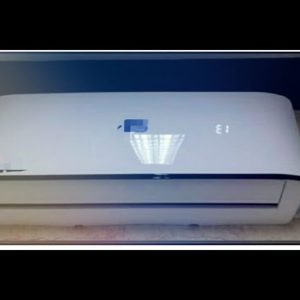hey guys I'm going to touch on a couple things
here the question that comes up a lot is e1 codes what possibly can happen for an e1 code and where
do you start you have your normal troubleshooting I've got a video on that how to do it with
a meter and you put on DC mode and put your two leads on two and three or either in an S it's
the same thing I'll show you on my training model here what you got but there's a couple of other
things that can cause an e1 code II one code is a communication between indoor and outdoor of a
mini-split and basically what that is the data signal in between that data signal is really
light and anything can interrupt it so there's actually a 5 volt sensor on the board itself
if that is disrupted and it's four and a half volts four volts three volts then that can throw
off the communication so I'm gonna show you how to check that and check sensors and that kind
of thing just to make sure you don't have an underlying issue and the main components of a
menace but most people haven't seen the cover off so they're very simple just trying to make
them too hard and once you understand what they are it's easier to figure out what we got so I'm
gonna flip the camera around just show you okay here's the training model and what we got is of
course this is your compressor these are your sensors you get a discharge temperature sensor you
have a coil temperature sensor down here and then on the other side in the front so you can say
that's your ambient temperature sensor so you got three main sensors on this thing you have a
reactor the job of the reactor is what that does is it removes amperage from the control board to
keep the control board from burning itself out so you have voltage but it removes the amperage so
here's a few things the reactor should have very little resistance zero resistance maybe 0.1 if
anything so only thinking calls it to fail is if the CELAC was to burn you would have a power surge
or something and it was short one wire to another other than that the reactors generally never fail
what we have on the sensors all right the sensors let me see if I can show you this up in here
these sensors mainly generally go to one plug let's see if you can see up in here right here is
the main plug and then those three sensors plug in separately to that plug one thing you can do and
you can test every sensor and I have a video of that but to keep this short what you can do is if
you have any one code and your question of which where the problem is whether it's a control board
whether it's the wiring whether it's a sensor what you do is unplug the sensors just unplug them you
will throw a sensor code but your a one would go away because if it throws the sensor code you know
that the outdoor unit is now communicating with the indoor unit so unplug your sensors let's see
if we can get it right here there's your main plug if I can get it in there zoom it in there right
there so unplug your main plug for your sensors and let's see if the e1 code goes away another
thing can happen is if you have an e XV valve right here that is one plug that exp valve see if
I can find the plug it's different on every one but all you do is just just follow your wire up
and right here it is this right beside the sensors so you can unplug that normally they will not ever
throw a code for an exp valve unplug exp see if it goes away it's an easy way of troubleshooting if
it does go away and system operates then you need to replace the exv and normally you don't have to
replace the whole one just a head the head comes off and the five volts I was talking about let
me find it on the board here if you look at the top of the board you will have voltage marks on
here here see if I can zoom in there so you can read it five volts so if you read from pin to pin
you should have a dedicated 5 volts constantly on that board if you don't have that 5 volts then
one of these could actually be your trouble and it could be just as simple as that so you might
not have a board problem you can actually have one of your sensors or TXV causing your problem
and the way you would read it on the meter if you look at my past video here we got 2 & 3 basically
what this is is L 2 and then 3 is our signal wire sometimes we have l1 l2 and s or in and s but
positive here negative there DC mode it should fluctuate between 0 and 50 volts positive to
negative so those are a few steps to take to help diagnose a II 1 code so hopefully this helps and
get you started in the right direction of course always inspect your board to make sure you don't
have any burnt spots no thing I should touch on is wouldn't you testing this there's a slack on
this board and it keeps corrosion and stuff off so when you test the 5 volts you might have to
scratch just a little bit before you do it and of course before you do then cut the power off
then cut your power on and test your voltage but you might can see that little bit of stuff they
put on it to keep the corrosion off okay hope this helps and all you want to do mini splits
I got kind of a variety of videos on there but like the video subscribe and I'm gonna have a lot
more videos coming up help you Hiep you guys out


